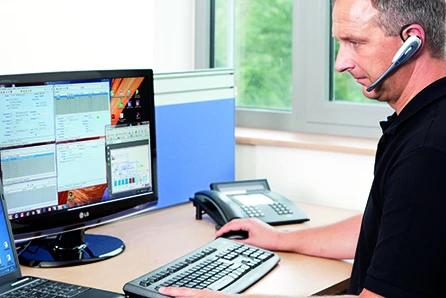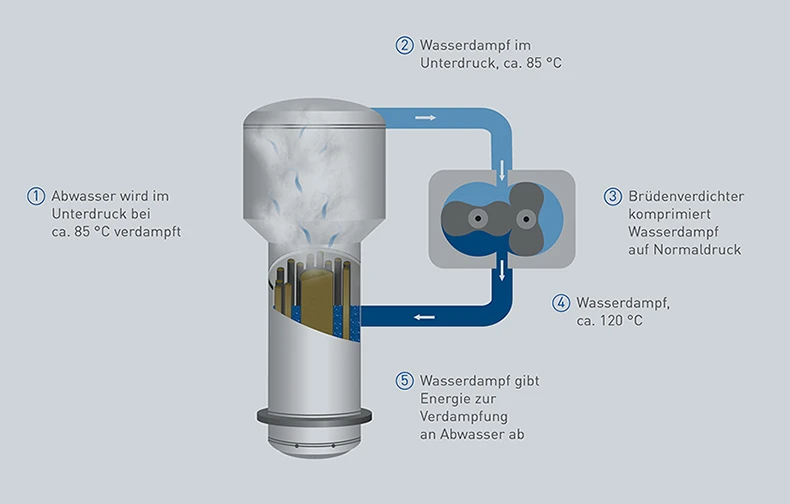Contact us
DBP Aquitaine became wastewater-free in 2015. At that time, the company replaced the chemical-physical treatment system with a modern VACUDEST vacuum evaporator. Over the years, the company had grown so much that the treatment capacity of the plant was no longer sufficient. They therefore installed a larger system - and because of the positive experience, the decision was again made in favour of a VACUDEST vacuum distillation system.
It met all of DBP's requirements: it had to be a fully automated system that used as few operating materials as possible. The aim was to save valuable time through less supervision, less maintenance and less monitoring.

DBP Aquitaine, based in Le Barp south of Bordeaux, offers various services for the surface treatment of stainless steel. DBP Aquitaine is part of the DBP-MAYET Group, whose headquarters and historic plant are located in Saint Priest, a suburb of Lyon. This plant is also equipped with a VACUDEST evaporator.
"The machine is reliable and requires little monitoring and maintenance, so we were able to achieve our goals and reuse our process water."
The production of stainless steel parts generates waste water from surface treatment that cannot simply be discharged:
Before 2015, the acidic water from these processes, up to 5 m3/day, was treated using a chemical-physical system that required a high level of staff presence. In particular, to dose the various reagents depending on the load of the incoming wastewater. This technology, which was effective and appropriate at the time of its acquisition, is now obsolete due to the high operating costs and time expenditure.
DBP Aquitaine wanted to equip itself so that it could treat its wastewater in future with the following requirements:
The first step is to examine the existing wastewater in a laboratory test at the application centre for zero liquid discharge production at H2O GmbH. This makes it possible to determine whether the evaporator technology fulfils the customer's desired requirements. Here, DBP was able to benefit from the experience of another DBP Group site that uses the same chemicals. It was therefore possible to start planning the plant straight away.
Hydrofluoric acid and nitric acid are present in a ratio that is compatible with standard 316Ti stainless steel. The sulphuric and phosphoric acids from electropolishing also pose no risk to the corrosion of the evaporator. This part must not be neglected under any circumstances, as it enables the isolation of potentially critical products or currents that could corrode the evaporator. If this is not the case, more corrosion-resistant steel grades can be provided.
The upstream storage capacities are used to store the wastewater awaiting treatment. In addition, a neutralisation tank has to be provided to readjust the pH value before evaporation. The evaporator does not accept acidic wastewater. A distillate storage tank for recycling is also provided by H2O.
Once the basis for the new wastewater solution had been created, the customer's specific requirements were analysed in detail:
The latest generation of VACUDEST vacuum evaporators is equipped with the modern Vacutouch control system, which also offers the option of remote maintenance by H2O customer service.

Intuitive operation: The Vacutouch machine control with remote maintenance option.
New digital services - Smart Services - are also available, saving users time and operating costs with an optimised system. The Smart Services cockpits make using the VACUDEST evaporator even easier: operators can see on the Vacutouch operating screen how efficiently the evaporator is working - and how they can easily optimise it. This means: more efficiency, more process reliability, lower costs and less stress.
OEE Performance Cockpit (Overall Equipment Effectiveness)
The Vacutouch machine control system provides a statistical 30-day overview of the overall efficiency of the system.
Condition Monitoring
Condition monitoring makes optimisation child's play. Clear statistics show which optimisations achieve the highest increase in performance.
Trend Cockpit
If the performance of the system decreases, the trend diagram shows this in real time. This allows operators to take small countermeasures in good time. This avoids costs for spare parts or service calls.
Health Report
The monthly e-mail report shows all the information about the VACUDEST system on a single page. Perfect for environmental audits.
The chemical-physical plant is to be replaced by a technology that consumes little energy and offers the possibility of recycling the wastewater. This is known as "zero release". The demineralised distillate, free of impurities, is stored in a tank until it is used by the high-pressure cleaners to rinse the parts after chemical treatment. It accounts for 94 per cent of the treated volume and has a conductivity of a few MicroSiemens/centimetre , which is significantly lower than that of the water grid. As a result, the parts are free of traces after rinsing. The concentrate therefore only makes up 6 per cent of the original volume. It is stored in IBCs with a capacity of 1000 litres until it is collected by a disposal company.
The VACUDEST M 1500 ClearCat vacuum evaporator, which can process up to 5 m³/day with a concentration factor of at least 16 or a maximum of 6 per cent concentrate, met the requirements. DBP Aquitaine opted for this solution in order to limit the number of journeys to and from the disposal site.
After five years of reliable operation, the growth of DBP Aquitaine is so strong that the capacity of the evaporator is no longer sufficient to treat all the wastewater. A machine with double the capacity, i.e. 3000 m3/year or 10 m3/day, therefore had to be replaced. DBP Aquitaine turned to H2O for this replacement because of the positive experience with the previous system.

Our modern Vacutouch machine control system enables convenient remote access to your VACUDEST vacuum evaporator via the Internet. This applies not only to us, but also to your operators. This saves time and money, as 4 out of 10 faults can be rectified without on-site intervention. - Further information
Thanks to smallceramic grinding balls in the heat exchanger, salt deposits in the tubes are prevented in order to maintain good heat exchange and thus reduce energy consumption. - Further information


Vacuum distillation plants work on the simple principle of separating substances according to boiling point differences: The industrial wastewater is evaporated under a reduced pressure at a temperature of only about 80 degrees, instead of 100 degrees as at atmospheric pressure. All substances that have a higher boiling point than water remain in the evaporation residue. This includes heavy metals, salts, but also oils, fats or surfactants. Because the water content is evaporated, the volume of the residue from distillation is reduced to 0.5 to 5 per cent of the original wastewater volume. The rising steam, also called vapor, is almost free of impurities. After condensation, it can be returned to the production as clean process water.
You have questions on our VACUDEST systems?
Kindly contact us!
Your contact is:
Thomas Dotterweich
Senior Sales Engineer
+49 7627 9239-306
thomasm.dotterweich@h2o-de.com
You need consumables, spare parts or a maintenance date?
We will be pleased to assist you!
Your contact is:
Carles Fité
Technical Customer Support
+49 7627 9239-888
carles.fite@h2o-de.com
You want to be part of our team and create the wastewater-free future with us?
We will tell you how!
Your contact is:
Bettina Böhringer
Human Resources
+49 7627 9239-201
career@h2o-de.com